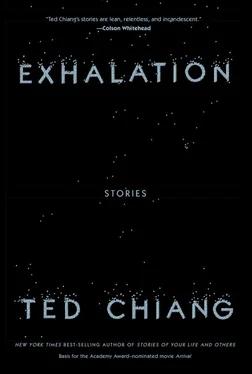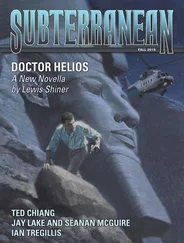It was generally hypothesized that the brain was divided into an engine located in the center of the head which performed the actual cognition, surrounded by an array of components in which memories were stored. What I observed was consistent with this theory, since the peripheral subassemblies seemed to resemble one another, while the subassembly in the center appeared to be different, more heterogeneous and with more moving parts. However, the components were packed too closely for me to see much of their operation; if I intended to learn anything more, I would require a more intimate vantage point.
Each subassembly had a local reservoir of air, fed by a hose extending from the regulator at the base of my brain. I focused my periscope on the rearmost subassembly and, using the remote manipulators, I quickly disconnected the outlet hose and installed a longer one in its place. I had practiced this maneuver countless times so that I could perform it in a matter of moments; even so, I was not certain I could complete the connection before the subassembly had depleted its local reservoir. Only after I was satisfied that the component’s operation had not been interrupted did I continue; I rearranged the longer hose to gain a better view of what lay in the fissure behind it: other hoses that connected it to its neighboring components. Using the most slender pair of manipulators to reach into the narrow crevice, I replaced the hoses one by one with longer substitutes. Eventually, I worked my way around the entire subassembly and replaced every connection it had to the rest of my brain. I was now able to unmount this subassembly from the frame that supported it and pull the whole section outside of what was once the back of my head.
I knew it was possible I had impaired my capacity to think and was unable to recognize it, but performing some basic arithmetic tests suggested that I was uninjured. With one subassembly hanging from a scaffold above, I now had a better view of the cognition engine at the center of my brain, but there was not enough room to bring the microscope attachment itself in for a close inspection. In order for me to really examine the workings of my brain, I would have to displace at least half a dozen subassemblies.
Laboriously, painstakingly, I repeated the procedure of substituting hoses for other subassemblies, repositioning another one farther back, two more higher up, and two others out to the sides, suspending all six from the scaffold above my head. When I was done, my brain looked like an explosion frozen an infinitesimal fraction of a second after the detonation, and again I felt dizzy when I thought about it. But at last the cognition engine itself was exposed, supported on a pillar of hoses and actuating rods leading down into my torso. I now also had room to rotate my microscope around a full three hundred and sixty degrees and pass my gaze across the inner faces of the subassemblies I had moved. What I saw was a microcosm of auric machinery, a landscape of tiny spinning rotors and miniature reciprocating cylinders.
As I contemplated this vista, I wondered where my body was. The conduits which displaced my vision and action around the room were in principle no different from those which connected my original eyes and hands to my brain. For the duration of this experiment, were these manipulators not essentially my hands? Were the magnifying lenses at the end of my periscope not essentially my eyes? I was an everted person, with my tiny, fragmented body situated at the center of my own distended brain. It was in this unlikely configuration that I began to explore myself.
I turned my microscope to one of the memory subassemblies and began examining its design. I had no expectation that I would be able to decipher my memories, only that I might divine the means by which they were recorded. As I had predicted, there were no reams of foil pages visible, but to my surprise neither did I see banks of gearwheels or switches. Instead, the subassembly seemed to consist almost exclusively of a bank of air tubules. Through the interstices between the tubules, I was able to glimpse ripples passing through the bank’s interior.
With careful inspection and increasing magnification, I discerned that the tubules ramified into tiny air capillaries, which were interwoven with a dense latticework of wires on which gold leaves were hinged. Under the influence of air escaping from the capillaries, the leaves were held in a variety of positions. These were not switches in the conventional sense, for they did not retain their position without a current of air to support them, but I hypothesized that these were the switches I had sought, the medium in which my memories were recorded. The ripples I saw must have been acts of recall, as an arrangement of leaves was read and sent back to the cognition engine.
Armed with this new understanding, I then turned my microscope to the cognition engine. Here too I observed a latticework of wires, but they did not bear leaves suspended in position; instead the leaves flipped back and forth almost too rapidly to see. Indeed, almost the entire engine appeared to be in motion, consisting more of lattice than of air capillaries, and I wondered how air could reach all the gold leaves in a coherent manner. For many hours I scrutinized the leaves, until I realized that they themselves were playing the role of capillaries; the leaves formed temporary conduits and valves that existed just long enough to redirect air at other leaves in turn, and then disappeared as a result. This was an engine undergoing continuous transformation, indeed modifying itself as part of its operation. The lattice was not so much a machine as it was a page on which the machine was written, and on which the machine itself ceaselessly wrote.
My consciousness could be said to be encoded in the position of these tiny leaves, but it would be more accurate to say that it was encoded in the ever-shifting pattern of air driving these leaves. Watching the oscillations of these flakes of gold, I saw that air does not, as we had always assumed, simply provide power to the engine that realizes our thoughts. Air is in fact the very medium of our thoughts. All that we are is a pattern of air flow. My memories were inscribed, not as grooves on foil or even the position of switches, but as persistent currents of argon.
In the moments after I grasped the nature of this lattice mechanism, a cascade of insights penetrated my consciousness in rapid succession. The first and most trivial was understanding why gold, the most malleable and ductile of metals, was the only material out of which our brains could be made. Only the thinnest of foil leaves could move rapidly enough for such a mechanism, and only the most delicate of filaments could act as hinges for them. By comparison, the copper burr raised by my stylus as I engrave these words and brushed from the sheet when I finish each page is as coarse and heavy as scrap. This truly was a medium where erasing and recording could be performed rapidly, far more so than any arrangement of switches or gears.
What next became clear was why installing full lungs into a person who has died from lack of air does not bring him back to life. These leaves within the lattice remain balanced between continuous cushions of air. This arrangement lets them flit back and forth swiftly, but it also means that if the flow of air ever ceases, everything is lost; the leaves all collapse into identical pendent states, erasing the patterns and the consciousness they represent. Restoring the air supply cannot re-create what has evanesced. This was the price of speed; a more stable medium for storing patterns would mean that our consciousnesses would operate far more slowly.
It was then that I perceived the solution to the clock anomaly. I saw that the speed of these leaves’ movements depended on their being supported by air; with sufficient air flow, the leaves could move nearly frictionlessly. If they were moving more slowly, it was because they were being subjected to more friction, which could occur only if the cushions of air that supported them were thinner, and the air flowing through the lattice was moving with less force.
Читать дальше









